sensor RENAULT CAPTUR 2016 1.G Owners Manual
[x] Cancel search | Manufacturer: RENAULT, Model Year: 2016, Model line: CAPTUR, Model: RENAULT CAPTUR 2016 1.GPages: 246, PDF Size: 2.55 MB
Page 65 of 246
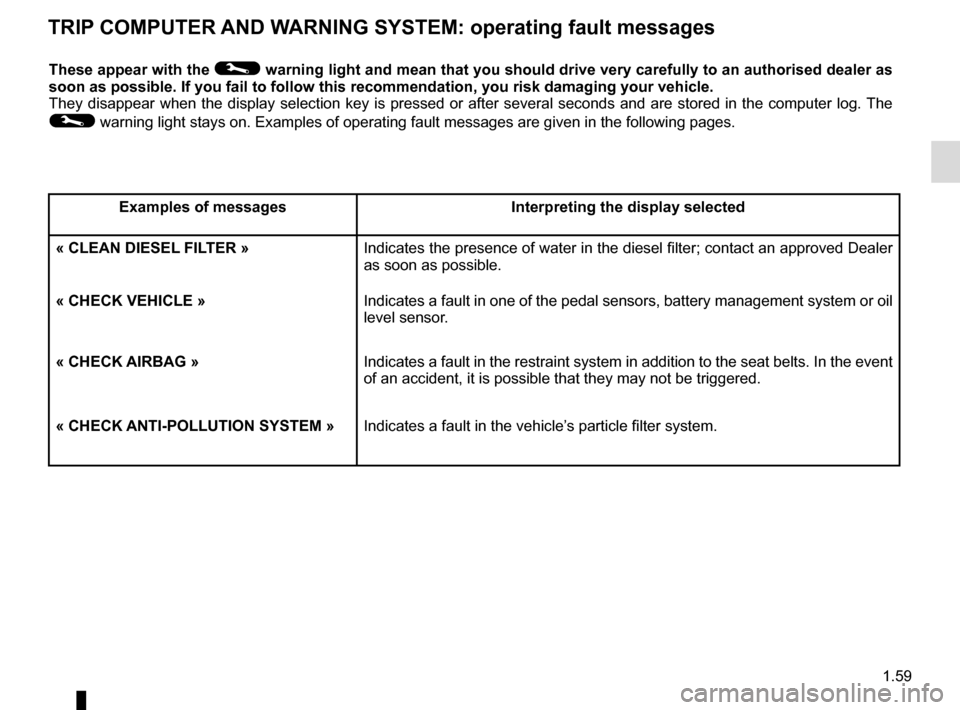
1.59
TRIP COMPUTER AND WARNING SYSTEM: operating fault messages
These appear with the © warning light and mean that you should drive very carefully to an author\
ised dealer as
soon as possible. If you fail to follow this recommendation, you risk da\
maging your vehicle.
They disappear when the display selection key is pressed or after severa\
l seconds and are stored in the computer log. The
© warning light stays on. Examples of operating fault messages are given \
in the following pages.
Examples of messages Interpreting the display selected
« CLEAN DIESEL FILTER » Indicates the presence of water in the diesel filter; contact an approve\
d Dealer
as soon as possible.
« CHECK VEHICLE » Indicates a fault in one of the pedal sensors, battery management system\
or oil
level sensor.
« CHECK AIRBAG » Indicates a fault in the restraint system in addition to the seat belts.\
In the event
of an accident, it is possible that they may not be triggered.
« CHECK ANTI-POLLUTION SYSTEM » Indicates a fault in the vehicle’s particle filter system.
Page 101 of 246
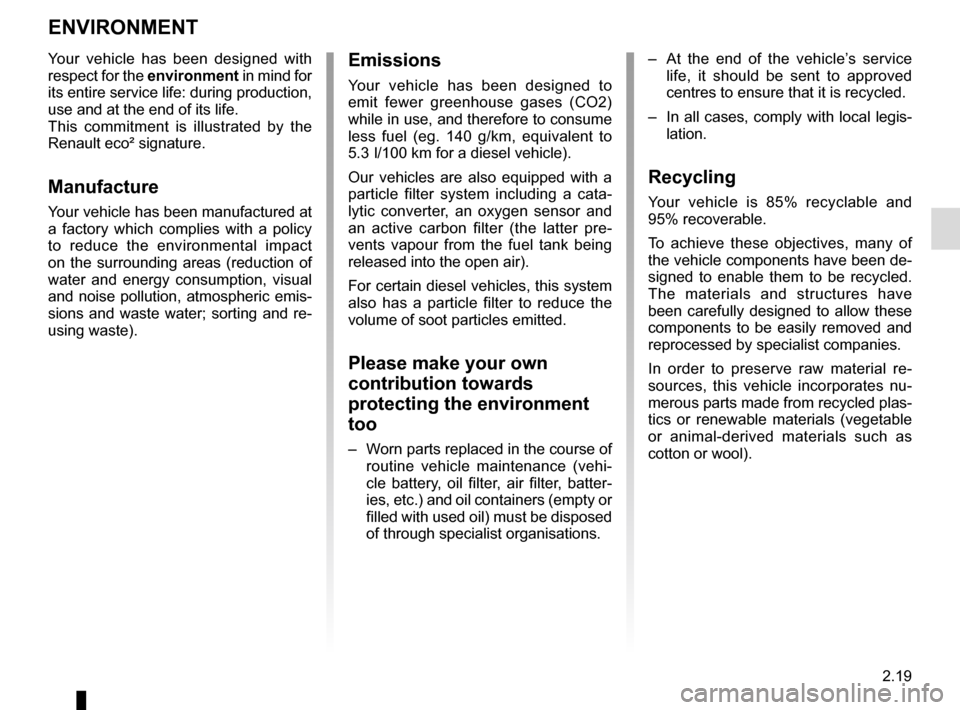
2.19
ENVIRONMENT
Emissions
Your vehicle has been designed to
emit fewer greenhouse gases (CO2)
while in use, and therefore to consume
less fuel (eg. 140 g/km, equivalent to
5.3 l/100 km for a diesel vehicle).
Our vehicles are also equipped with a
particle filter system including a cata-
lytic converter, an oxygen sensor and
an active carbon filter (the latter pre-
vents vapour from the fuel tank being
released into the open air).
For certain diesel vehicles, this system
also has a particle filter to reduce the
volume of soot particles emitted.
Please make your own
contribution towards
protecting the environment
too
– Worn parts replaced in the course of routine vehicle maintenance (vehi-
cle battery, oil filter, air filter, batter-
ies, etc.) and oil containers (empty or
filled with used oil) must be disposed
of through specialist organisations. – At the end of the vehicle’s service
life, it should be sent to approved
centres to ensure that it is recycled.
– In all cases, comply with local legis- lation.
Recycling
Your vehicle is 85% recyclable and
95% recoverable.
To achieve these objectives, many of
the vehicle components have been de-
signed to enable them to be recycled.
The materials and structures have
been carefully designed to allow these
components to be easily removed and
reprocessed by specialist companies.
In order to preserve raw material re-
sources, this vehicle incorporates nu-
merous parts made from recycled plas-
tics or renewable materials (vegetable
or animal-derived materials such as
cotton or wool).
Your vehicle has been designed with
respect for the environment in mind for
its entire service life: during production,
use and at the end of its life.
This commitment is illustrated by the
Renault eco² signature.Manufacture
Your vehicle has been manufactured at
a factory which complies with a policy
to reduce the environmental impact
on the surrounding areas (reduction of
water and energy consumption, visual
and noise pollution, atmospheric emis-
sions and waste water; sorting and re-
using waste).
Page 106 of 246
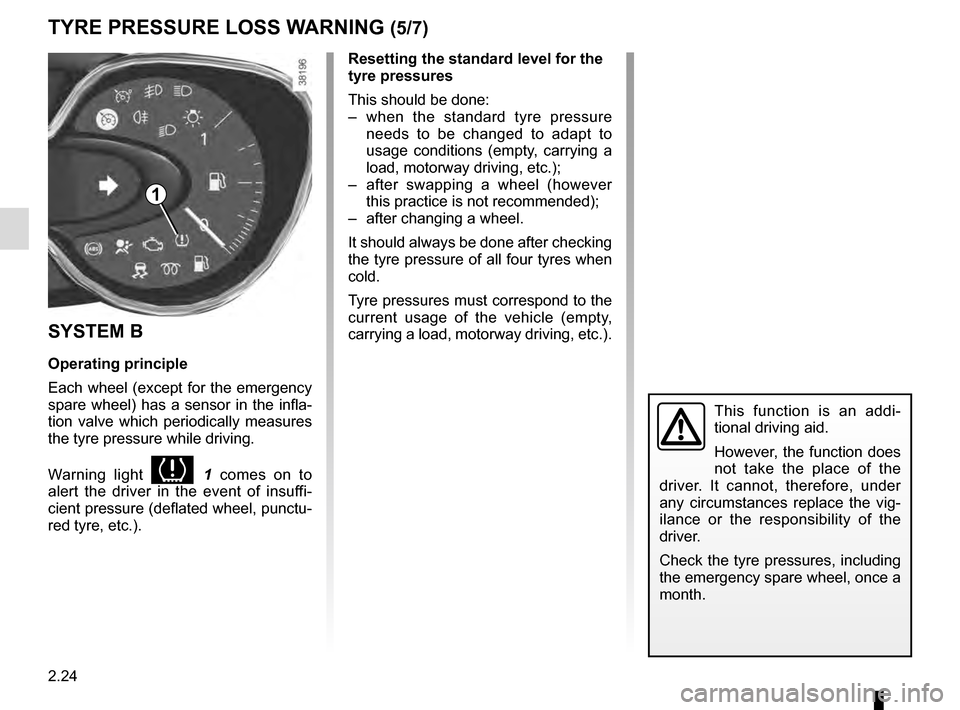
2.24
TYRE PRESSURE LOSS WARNING (5/7)
SYSTEM B
Operating principle
Each wheel (except for the emergency
spare wheel) has a sensor in the infla-
tion valve which periodically measures
the tyre pressure while driving.
Warning light
1 comes on to
alert the driver in the event of insuffi-
cient pressure (deflated wheel, punctu-
red tyre, etc.).
Resetting the standard level for the
tyre pressures
This should be done:
– when the standard tyre pressure needs to be changed to adapt to
usage conditions (empty, carrying a
load, motorway driving, etc.);
– after swapping a wheel (however this practice is not recommended);
– after changing a wheel.
It should always be done after checking
the tyre pressure of all four tyres when
cold.
Tyre pressures must correspond to the
current usage of the vehicle (empty,
carrying a load, motorway driving, etc.).
This function is an addi-
tional driving aid.
However, the function does
not take the place of the
driver. It cannot, therefore, under
any circumstances replace the vig-
ilance or the responsibility of the
driver.
Check the tyre pressures, including
the emergency spare wheel, once a
month.
1
Page 108 of 246

2.26
TYRE PRESSURE LOSS WARNING (7/7)
SYSTEM B (cntd.)
“CHECK TYRE PRESSURE
SENSORS”
The warning light
flashes for
several seconds, then stays on, along
with the message “CHECK TYRE
PRESSURE SENSORS”.
This message is accompanied by the
warning light
©.
They indicate that at least one tyre is
not fitted with sensors (e.g. emergency
spare wheel). In other cases, contact
an authorised dealer.
Readjustment of tyre pressures
The tyre pressures must be adjusted
when cold (please refer to the label lo-
cated on the edge of the driver’s door).
If tyre pressures cannot be checked
when the tyres are cold, the recom-
mended pressures must be increased
by 0.2 to 0.3 bar (3 PSI).
Never deflate a hot tyre.
Replacing wheels/tyres
This system requires specific equip-
ment (wheels, tyres, hubcaps, etc.).
Please see the information on “Tyres”
in Section 5.
Contact an approved Dealer to fit new
tyres and to find out about available ac-
cessories compatible with the system
and available from your dealer net-
work: the use of any other accessory
could affect the correct operation of the
system or damage a sensor. Emergency spare wheel
If the vehicle is equipped with an emer- -
gency spare wheel, it will not have a
sensor.
Tyre repair product and inflation kit
Because the valves are specially desi-
gned, only use equipment approved by
the approved network. Please refer to
“Tyre inflation kit” in Section 5.
Page 110 of 246
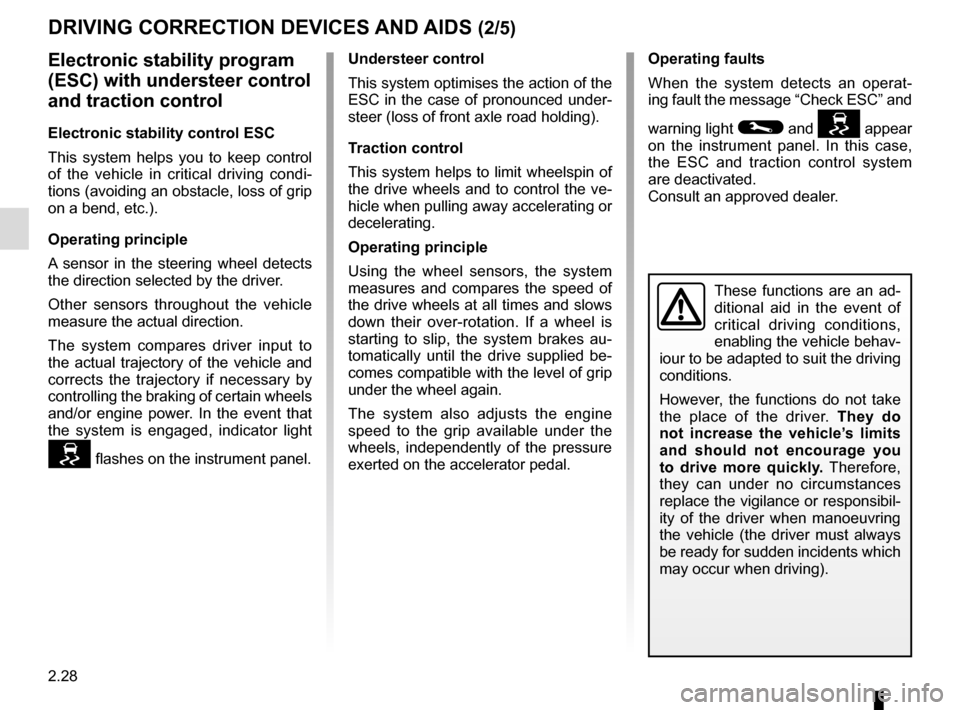
2.28
DRIVING CORRECTION DEVICES AND AIDS (2/5)
Electronic stability program
(ESC) with understeer control
and traction control
Electronic stability control ESC
This system helps you to keep control
of the vehicle in critical driving condi-
tions (avoiding an obstacle, loss of grip
on a bend, etc.).
Operating principle
A sensor in the steering wheel detects
the direction selected by the driver.
Other sensors throughout the vehicle
measure the actual direction.
The system compares driver input to
the actual trajectory of the vehicle and
corrects the trajectory if necessary by
controlling the braking of certain wheels
and/or engine power. In the event that
the system is engaged, indicator light
flashes on the instrument panel.Understeer control
This system optimises the action of the
ESC in the case of pronounced under-
steer (loss of front axle road holding).
Traction control
This system helps to limit wheelspin of
the drive wheels and to control the ve-
hicle when pulling away accelerating or
decelerating.
Operating principle
Using the wheel sensors, the system
measures and compares the speed of
the drive wheels at all times and slows
down their over-rotation. If a wheel is
starting to slip, the system brakes au-
tomatically until the drive supplied be-
comes compatible with the level of grip
under the wheel again.
The system also adjusts the engine
speed to the grip available under the
wheels, independently of the pressure
exerted on the accelerator pedal.
These functions are an ad-
ditional aid in the event of
critical driving conditions,
enabling the vehicle behav-
iour to be adapted to suit the driving
conditions.
However, the functions do not take
the place of the driver. They do
not increase the vehicle’s limits
and should not encourage you
to drive more quickly. Therefore,
they can under no circumstances
replace the vigilance or responsibil-
ity of the driver when manoeuvring
the vehicle (the driver must always
be ready for sudden incidents which
may occur when driving).
Operating faults
When the system detects an operat-
ing fault the message “Check ESC” and
warning light
© and appear
on the instrument panel. In this case,
the ESC and traction control system
are deactivated.
Consult an approved dealer.
Page 219 of 246
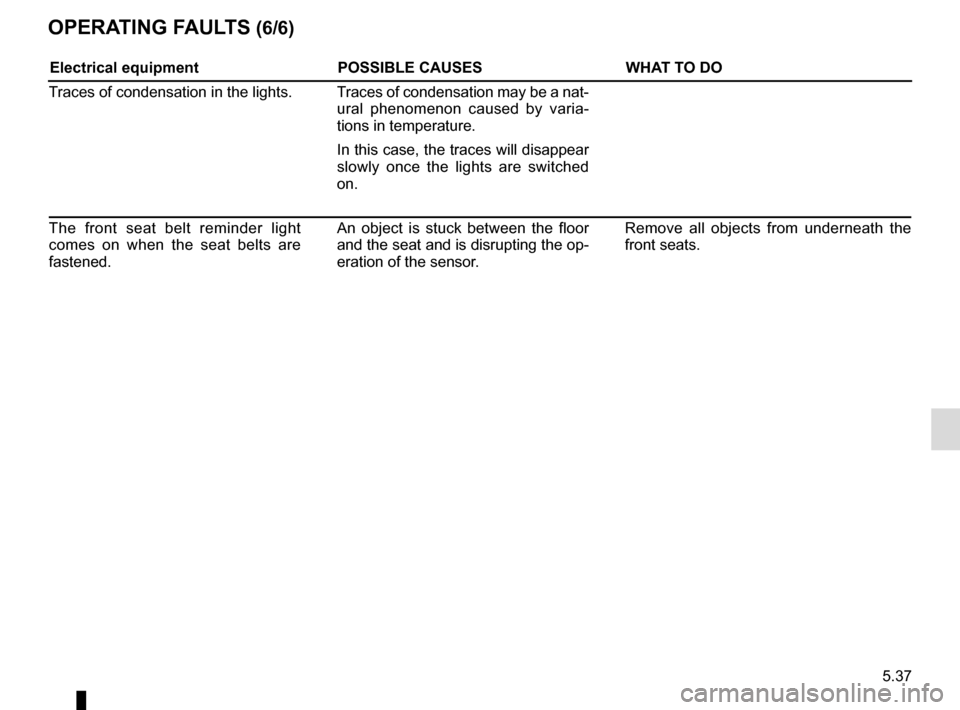
5.37
OPERATING FAULTS (6/6)
Electrical equipmentPOSSIBLE CAUSESWHAT TO DO
Traces of condensation in the lights. Traces of condensation may be a nat- ural phenomenon caused by varia-
tions in temperature.
In this case, the traces will disappear
slowly once the lights are switched
on.
The front seat belt reminder light
comes on when the seat belts are
fastened. An object is stuck between the floor
and the seat and is disrupting the op-
eration of the sensor.Remove all objects from underneath the
front seats.
Page 242 of 246
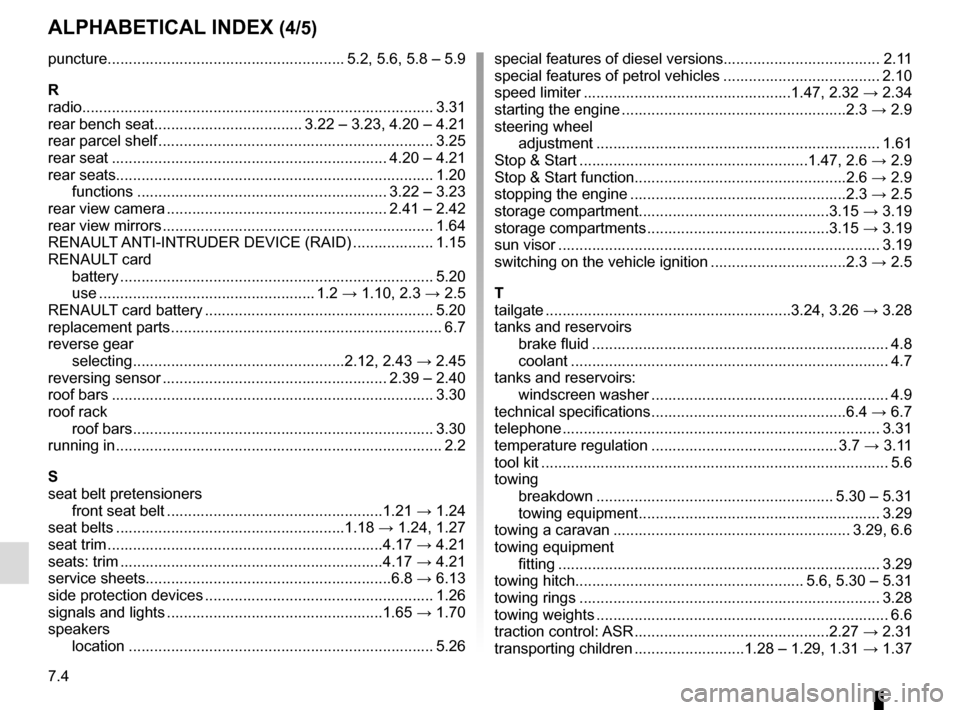
7.4
ALPHABETICAL INDEX (4/5)
puncture........................................................ 5.2, 5.6, 5.8 – 5.9
R
radio...................................................................\
................ 3.31
rear bench seat................................... 3.22 – 3.23, 4.20 – 4.21
rear parcel shelf ................................................................. 3.25
rear seat ................................................................. 4.20 – 4.21
rear seats..............................................................\
............. 1.20functions ........................................................... 3.22 – 3.23
rear view camera .................................................... 2.41 – 2.42
rear view mirrors ................................................................ 1.64
RENAULT ANTI-INTRUDER DEVICE (RAID) ................... 1.15
RENAULT card battery ................................................................\
.......... 5.20
use ................................................... 1.2 → 1.10, 2.3 → 2.5
RENAULT card battery ...................................................... 5.20
replacement parts ................................................................ 6.7
reverse gear selecting ..................................................2.12, 2.43 → 2.45
reversing sensor ..................................................... 2.39 – 2.40
roof bars ........................................................................\
.... 3.30
roof rack roof bars ....................................................................... 3.30
running in ........................................................................\
..... 2.2
S
seat belt pretensioners front seat belt ...................................................1.21 → 1.24
seat belts ......................................................1.18 → 1.24, 1.27
seat trim .................................................................4.17 → 4.21
seats: trim ..............................................................4.17 → 4.21
service sheets..........................................................\
6.8 → 6.13
side protection devices ...................................................... 1.26
signals and lights ...................................................1.65 → 1.70
speakers location ...............................................................\
......... 5.26 special features of diesel versions.....................................\
2.11
special features of petrol vehicles ..................................... 2.10
speed limiter .................................................1.47, 2.32 → 2.34
starting the engine .....................................................2.3 → 2.9
steering wheel adjustment .............................................................\
...... 1.61
Stop & Start ......................................................1.47, 2.6 → 2.9
Stop & Start function..................................................2.6 → 2.9
stopping the engine ...................................................2.3 → 2.5
storage compartment.............................................3.15 → 3.19
storage compartments ...........................................3.15 → 3.19
sun visor ........................................................................\
.... 3.19
switching on the vehicle ignition ................................2.3 → 2.5
T
tailgate ..........................................................3.24,\
3.26 → 3.28
tanks and reservoirs brake fluid ...................................................................... 4.8
coolant ................................................................\
........... 4.7
tanks and reservoirs: windscreen washer ........................................................ 4.9
technical specifications ..............................................6.4 → 6.7
telephone ..............................................................\
............. 3.31
temperature regulation ............................................ 3.7 → 3.11
tool kit ........................................................................\
.......... 5.6
towing breakdown ........................................................ 5.30 – 5.31
towing equipment ......................................................... 3.29
towing a caravan ........................................................ 3.29, 6.6
towing equipment fitting ................................................................\
............ 3.29
towing hitch...................................................... 5.6, 5.30 – 5.31
towing rings ....................................................................... 3.28
towing weights ..................................................................... 6.6
traction control: ASR ..............................................2.27 → 2.31
transporting children ..........................1.28 – 1.29, 1.31 → 1.37